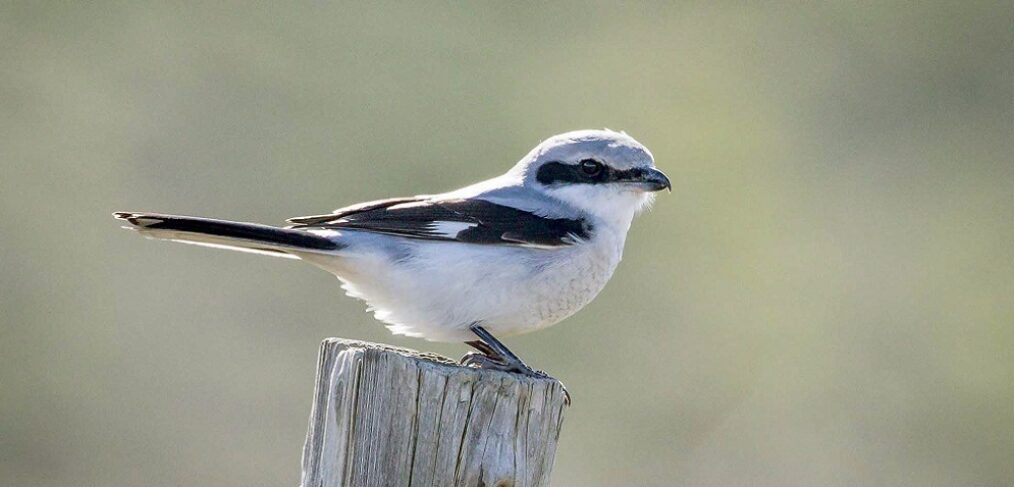
Species of the week #103 – Great Grey Shrike
The Great Grey Shrike sits on exposed perches like a real bird of prey and watches its prey. The fact that it is much smaller than a buzzard or a kite does not seem to impress the Great Grey Shrike; it is a true hunter. Because of its skilful hunting behaviour, the myth has arisen that the Great Grey Shrike is a shrunken bird of prey. This is not the case; biologically speaking, the Great Grey Shrike is a passerine bird.
| Distribution status in Rhineland-Palatinate | Threatened with extinction |
| Remaining occurances | Rhön, Saxony, Lower Saxony |
| Last sigting in Rhineland-Palatinate | current |
| Habitat | Habitat Semi-open landscapes in hilly areas with adjacent wetlands. |
| Threats | Cleared landscape, intensive agriculture, pest control |
The Great Grey Shrike loves voles and is therefore a rare but welcome guest among many gardeners. After hunting, it often impales its prey on thorns or jams them into branch forks as a supply for bad weather periods. During the mating season, the Great Grey Shrike tends to accumulate a lot of food to impress the females.
The Great Grey Shrike is a grey bird about the size of a blackbird with a black mask. The characteristic flight pattern shows its wings, which are largely white underneath, and its white belly, as well as its long, diamond-shaped tail with a white edge. Males can be distinguished from females by their stronger colouration and dark bill, and they are also slightly smaller and lighter than females.
Great Grey Shrikes are at home in semi-open landscapes such as moorlands, pastures or dwarf shrub heaths. The alternation of open areas and individual bushes, shrubs or trees, which can serve as roosts or nesting sites, is crucial. The Great Grey Shrike builds its nest exposed to the sun on trees, often on fruit trees or in higher, ideally thorny shrubs or hedges. Because they like large, open spaces, they are more often found on military training areas and abandoned open-cast mines. Accordingly, the only known breeding occurrence of the Great Grey Shrike in Rhineland-Palatinate is on the Baumholder military training area. The two sister species of the Great Grey Shrike, the Red-headed Shrike and the Black-fronted Shrike, are already extinct in Rhineland-Palatinate.
The European population, mainly in Russia, is estimated at around 300,000 breeding pairs; the Great Grey Shrike is classified as “endangered” on the European Red List, with a further declining trend. In Rhineland-Palatinate, the population was already at only 80 – 100 breeding pairs at the beginning of the 1990s. In neighbouring Saarland, the population was also estimated at less than 50 breeding pairs. The Great Grey Shrike is now a rare breeding and annual bird in Rhineland-Palatinate. Most of the 68 reports in Rhineland-Palatinate refer to migrants and winter visitors from other regions. and already existed in the Ebenberg nature reserve near Landau,
In addition to preserving and protecting the few existing breeding areas, former habitats could be re-established through extensification of agriculture. More and more paved roads in the landscape bring cars, agricultural machinery and people, which disturb breeding Great Grey Shrikes. Increasing the size of undisturbed areas would greatly help the Great Grey Shrike. If there were then more bushes, trees and hedges between fields and meadows, and insect diversity was increased by reduced fertiliser and biocide inputs, many people could rejoice at the return of the small predator.
Politically necessary:
– Reduction of dirt roads to create larger, undisturbed islands.
– Extensification of agriculture
– Increase insect diversity
Photo : By Smudge 9000 from North Kent Coast, England – Great Grey Shrike, CC BY-SA 2.0, https://commons.wikimedia.org/w/index.php?curid=42872421
Click here for more exciting species of the week
